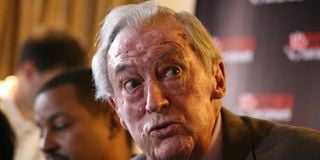Leakey's lifetime dedication to justice for man and nature

Dr Richard Leakey at a press conference on March 19, 2014.
What you need to know:
- In 1999, Dr Leakey became Head of Public Service, amid rampant corruption in key State corporations.
- Dr Leakey was once unseated by a horse and survived a puff adder attack, kidney failure and even a plane crash in 1983.
Dr Richard Leakey, one of the world's most renown conservationists, is dead. He was 77. Born on December 19, 1944, in Nairobi, Richard, the second-born son of world-renowned archeologist Louis Seymour Leakey and Mary Leakey, devoted his life to conservation work at a young age.
He not only dropped out of school at the age of 16, then in Form Two, upon which he spent the next few years trying different things, among them, a tour company, snake keeping and trade in skeletons, but also quickly rose to the directorship of the National Museums of Kenya aged just 22.
His choice of a career in paleoanthropology, and as a conservationist, arguably, followed his having accompanied his father on many excavation expeditions as a young man.
Having served as the Director of the National Museums of Kenya between 1968 and 1989, he was appointed Head of Wildlife Conservation and Management Department, later known as Kenya Wildlife Service (KWS), in 1990, at a time when the vice of poaching badly scourged the Kenyan wildlife.
In 1999, he became Head of Public Service, amid rampant corruption in key State corporations and crippling policy disapprobation by the International Monetary Fund (IMF) and the World Bank.
His tough stance on corruption earned him many enemies who saw to it that he was winkled out of his headship of the civil service in the early 2000s. He was once unseated by a horse and survived a puff adder attack, kidney failure and even a plane crash in 1983.
Leakey's books
He also joined the clamour for multi-party democracy, becoming a founding member of the Opposition party, Safina, in 1997. Between 1998 and 1999, he briefly returned to the Kenya Wildlife Service (KWS), before serving as Secretary to the Cabinet between 1999 and 2001.
And he was, variously, chairperson of the Kenya Wildlife Service Board of Directors. Mr Leakey once asserted that Africa had been the veritable home of man for more than 3.5 million years and, in 1991, personally raised $150 million dollars, which he ring-fenced for State projects focusing on conservation work.
A few years ago, President Uhuru Kenyatta, who led Kenyans in mourning Leakey following the latter's death on Sunday, January 2, 2022, appointed him chair of the Kenya Wildlife Service (KWS) and he (Leakey), it's said, was in the middle of some quasi-official endeavour - Ngaren Project - a privately-run fund towards the exploration of "the forces that shape Earth's climate, evolution and the timescale of humans' existence and impact" at the time of his death.
Leakey appeared on the cover of 'Time Magazine' in 1977. He co-authored two books with Roger Lewin, Origins (1977) and People Of The Lake (1978), that tried to "establish" the link between fossils and the modern Man. His other book, The Making Of Mankind (1981), essentially focuses on his anthropological work.
Over the years, he'd wheeled in his wife, Meave, and daughter, Louise, to help with anthropological research work, particularly in the northern Kenya part of Turkana. And his death, which coincided with that of his long-time friend, the country's first indigenous Attorney-General, Charles Njonjo, comes months after that of yet another conservationist, Joannah Stutchbury, who was murdered a few metres from her home in Kiambu in July last year.
Conservation efforts
It also comes barely a month after that of the art collector, cultural conservationist, historian and archivist Alan Donovan, at the age of 83, on Sunday, December 5, last year.
The death of Leakey, no doubt, deals further blow to conservation efforts and work in this country. After the deaths of Oscar-nominated film-maker Joan Roots in 2006, Esmond Bradley-Martin (found dead at his house), Joy Adamson and Robert Kiprotich (body found in Embobut Forest in 2018), a poisoned political and security atmosphere took the gilt off the gingerbread for most would-be enthusiasts of environmental conservation.
The world over, rights activists, journalists, environmentalists, whistle-blowers and such public-spirited characters often have a near-daily brush with harm and death as part of their work.
Most of the time, these men and women are up against threats, intimidation and the real risk of dying while going about the business of making this world a better place and home for us all. They incarnate the human interest in these words of the Rev Dr Martin Luther King Jr: “All labour that uplifts humanity has dignity and importance, and should be undertaken with painstaking excellence.” Historians, archeologists and anthropologists, such as the late Richard Leakey and Alan Donovan, help society establish and appreciate the place of humankind's unique story.
Yet an objective and critical analysis of their works’ nature and output throws up a reproach to Man's not-strong-nor-good-enough relationship to nature. Man-made imbalance in the wild's ecosystem, for example, spawns human-wildlife conflict, such as we’ve often seen in those parts of our country that abut on game reserves.
Mr Baraza is a votary of global peace, historian, writer, thinker and founder Public Affairs Volunteers for Global Peace and Climate Justice (PAVGPCJ). [email protected]





